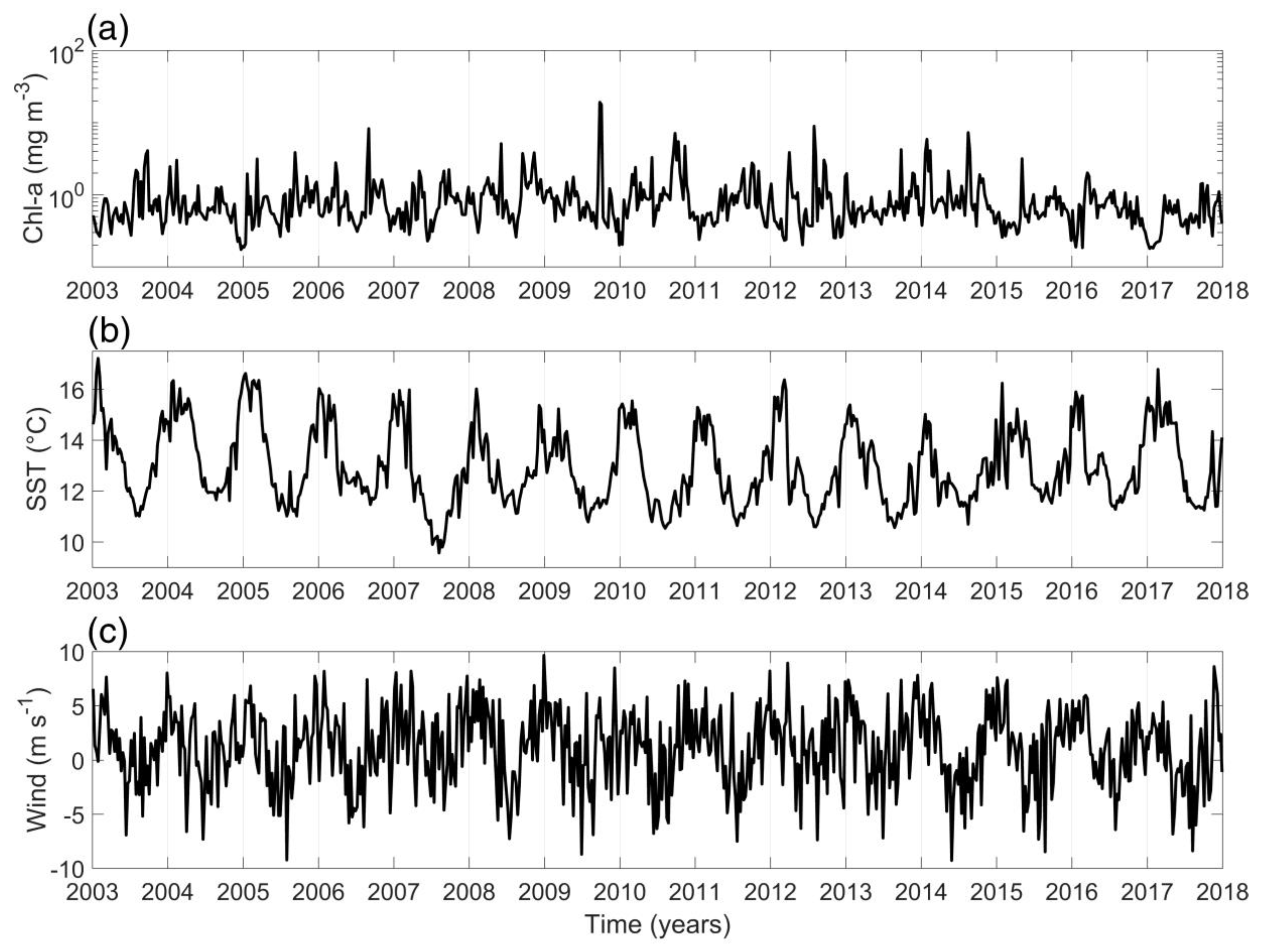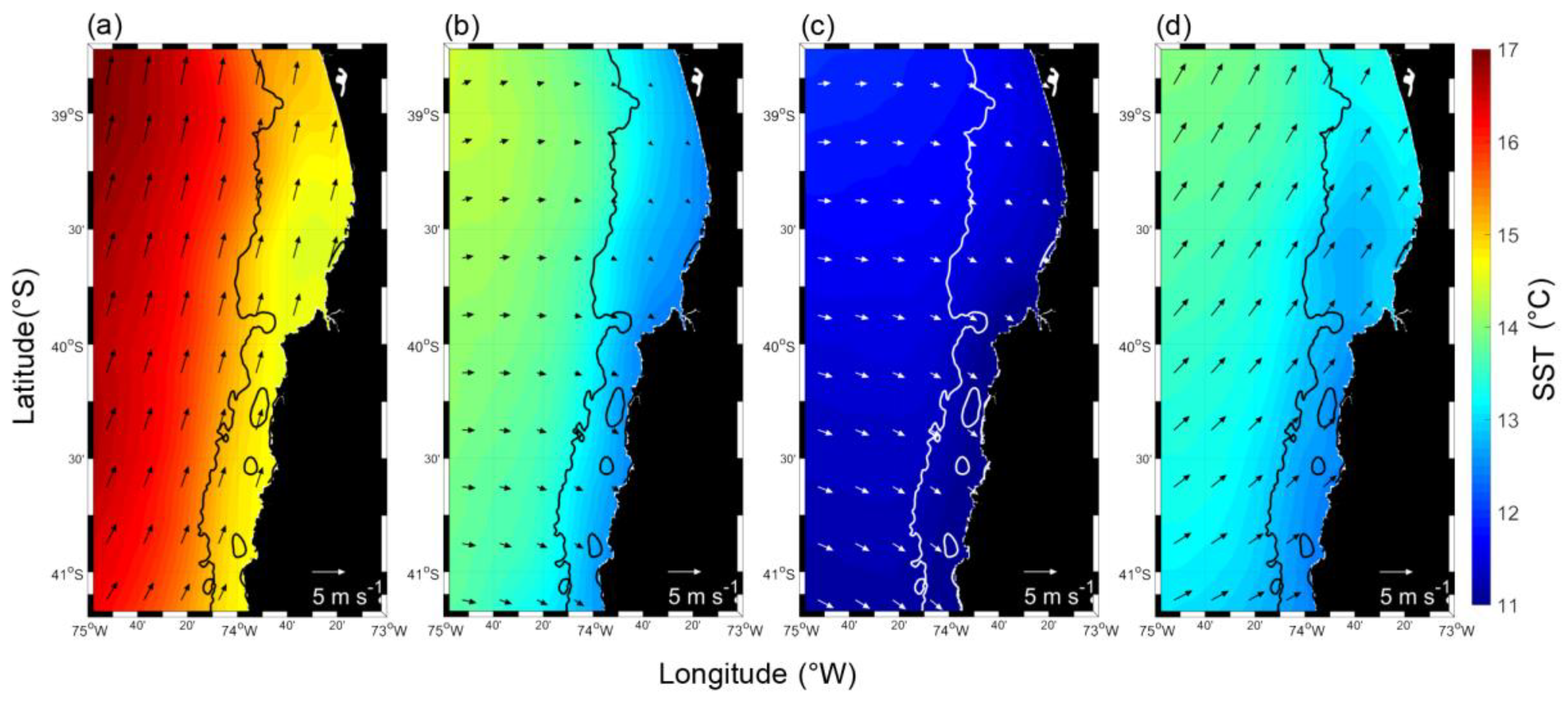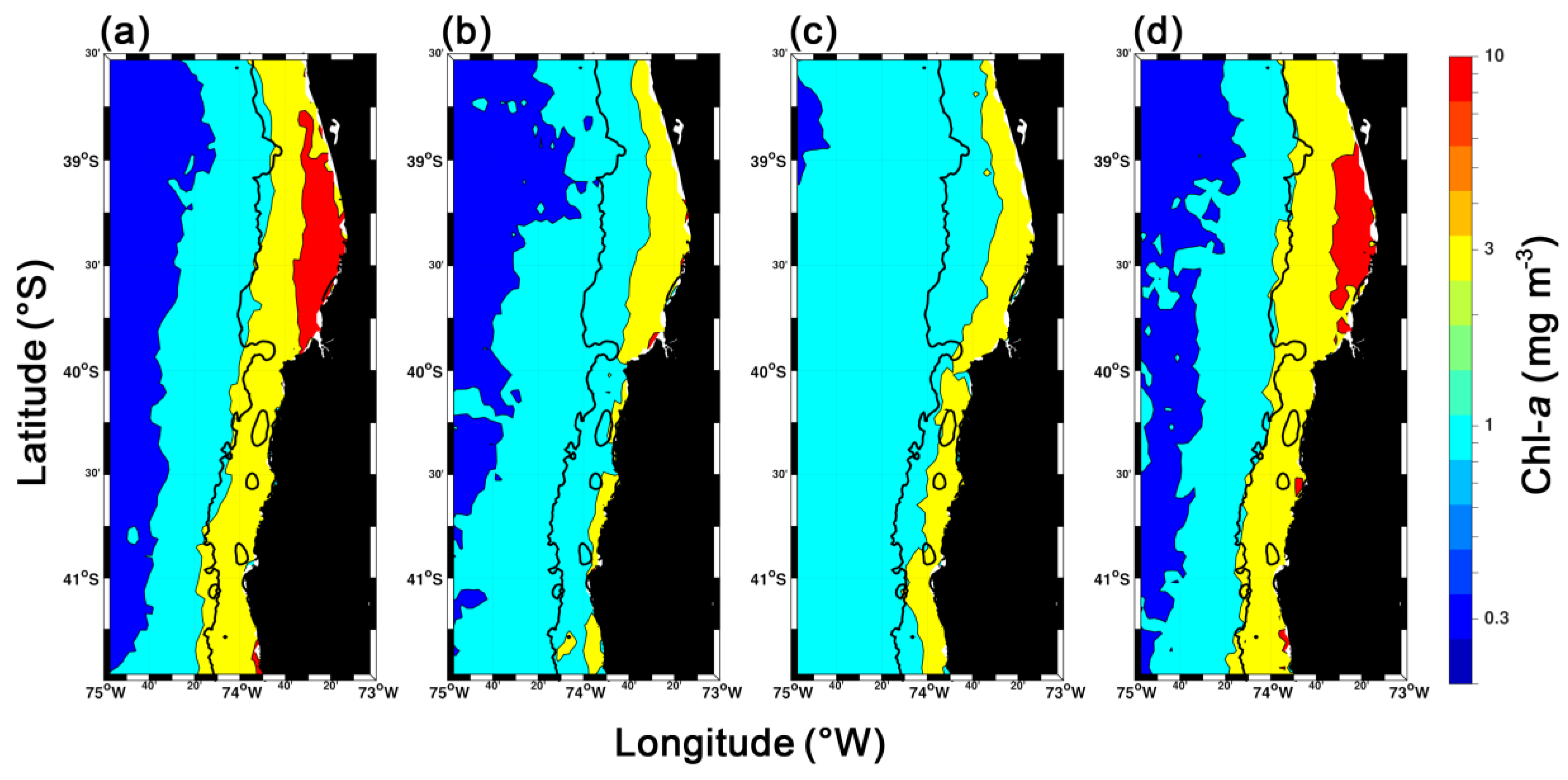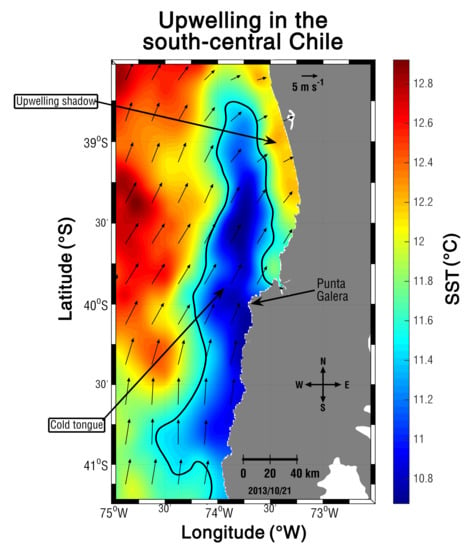Seasonal Variability of Upwelling off Central-Southern Chile
Abstract
:1. Introduction
2. Materials and Methods
2.1. Satellite Data: Sea Surface Temperature, Chlorophyll-a Concentration, and Sea Surface Winds
2.2. Methodology
3. Results
3.1. Seasonal Chlorophyll-a Concentration, Sea Surface Temperature, and Sea Surface Wind Cycle
3.2. Seasonal Variability of Sea Surface Temperature and Sea Surface Wind Fields
3.3. Seasonal Variability of Surface Chlorophyll-a Concentration Field
3.4. Surface Wind Forcing Effects on Sea Surface Temperature and Surface Chlorophyll-a Concentration
4. Discussion
4.1. Seasonal Variability of Chlorophyll-a Concentration, Sea Surface Temperature, and Alongshore SSW Cycle at Punta Galera
4.2. Seasonal Variability of Chlorophyll-a Concentration, Sea Surface Temperature, and Sea Surface Wind Fields
4.3. Effects of Sea Surface Wind Forcing on Sea Surface Temperature and Chlorophyll-a Concentration
4.4. Potential Implications of Upwelling in Punta Galera due to Climate Change
5. Conclusions
Author Contributions
Funding
Acknowledgments
Conflicts of Interest
References
- Patti, B.; Guisande, C.; Vergara, A.; Riveiro, I.; Maneiro, I.; Barreiro, A.; Bonanno, A.; Buscaino, G.; Cuttitta, A.; Basilone, G. Factors responsible for the differences in satellite-based chlorophyll a concentration between the major global upwelling areas. Estuar. Coast. Shelf Sci. 2008, 76, 775–786. [Google Scholar] [CrossRef]
- Carr, M.E.; Kearns, E.J. Production regimes in four Eastern Boundary Current systems. Deep Sea Res. Part Ii Top. Stud. Oceanogr. 2003, 50, 3199–3221. [Google Scholar] [CrossRef]
- Thiel, M.; Macaya, E.C.; Acuna, E.; Arntz, W.E.; Bastias, H.; Brokordt, K.; Camus, P.A.; Castilla, J.C.; Castro, L.R.; Cortes, M. The Humboldt Current System of northern and central Chile: Oceanographic processes, ecological interactions and socioeconomic feedback. Oceanogr. Mar. Biol. 2007, 45, 195–344. [Google Scholar]
- Morales, C.E.; Hormazabal, S.; Andrade, I.; Correa-Ramirez, M.A. Time-Space Variability of Chlorophyll-a and Associated Physical Variables within the Region off Central-Southern Chile. Remote Sens. Basel 2013, 5, 5550–5571. [Google Scholar] [CrossRef] [Green Version]
- FAO. El Estado Mundial de la Pesca y la Acuicultura 2016—Contribución a la Seguridad Alimentaria y la Nutrición Para Todos; Organización de las Naciones Unidas para la Alimentación y la Agricultura: Roma, Italia, 2016. [Google Scholar]
- Fuenzalida, R.; Schneider, W.; Garcés-Vargas, J.; Bravo, L. Satellite altimetry data reveal jet-like dynamics of the Humboldt Current. J. Geophys. Res. Ocean. 2008, 113. [Google Scholar] [CrossRef]
- Ancapichún, S.; Garcés-Vargas, J. Variability of the Southeast Pacific Subtropical Anticyclone and its impact on sea surface temperature off north-central Chile. Cienc. Mar. 2015, 41, 1–20. [Google Scholar] [CrossRef] [Green Version]
- Aguirre, C.; Pizarro, O.; Strub, P.T.; Garreaud, R.; Barth, J.A. Seasonal dynamics of the near-surface alongshore flow off central Chile. J. Geophys. Res. Ocean. 2012, 117. [Google Scholar] [CrossRef] [Green Version]
- Strub, P.T.; James, C.; Montecino, V.; Rutllant, J.A.; Blanco, J.L. Ocean circulation along the southern Chile transition region (38–46° S): Mean, seasonal and interannual variability, with a focus on 2014–2016. Prog. Oceanogr. 2019, 172. [Google Scholar] [CrossRef]
- Bello, M.; Barbieri, M.; Salinas, S.; Soto, L. Surgencia costera en la zona central de Chile, durante el ciclo El Niño-La Niña 1997–1999. In El Niño-La Niña 1997-2000. Sus Efectos en Chile; Avaria, S., Carrasco, J., Rutland, J., Yañez, E., Eds.; CONA: Valparaíso, Chile, 2004; pp. 77–94. [Google Scholar]
- Rutllant, J.; Montecino, V. Multiscale upwelling forcing cycles and biological response off north-central Chile. Rev. Chil. De Hist. Nat. 2002, 75, 217–231. [Google Scholar] [CrossRef] [Green Version]
- Letelier, J.; Pizarro, O.; Nuñez, S. Seasonal variability of coastal upwelling and the upwelling front off central Chile. J. Geophys. Res. Ocean. 2009, 114. [Google Scholar] [CrossRef] [Green Version]
- Völker, D.; Geersen, J.; Contreras-Reyes, E.; Sellanes, J.; Pantoja, S.; Rabbel, W.; Thorwart, M.; Reichert, C.; Block, M.; Weinrebe, W.R. Morphology and geology of the continental shelf and upper slope of southern Central Chile (33–43° S). Int. J. Earth Sci. 2014, 103, 1765–1787. [Google Scholar] [CrossRef]
- Garreaud, R.D.; Falvey, M. The coastal winds off western subtropical South America in future climate scenarios. Int. J. Climatol. 2008, 29, 543–554. [Google Scholar] [CrossRef]
- Gatica, C.; Arteaga, M.; Giacaman, J.; Ruiz, P. Tendencias en la biomasa de sardina común (Strangomera bentincki) y anchoveta (Engraulis ringens) en la zona centro-sur de Chile, entre 1991 y 2005. Investig. Mar. 2007, 35, 13–24. [Google Scholar] [CrossRef]
- Chin, T.M.; Vazquez-Cuervo, J.; Armstrong, E.M. A multi-scale high-resolution analysis of global sea surface temperature. Remote Sens. Environ. 2017, 200, 154–169. [Google Scholar] [CrossRef]
- Chin, T.M.; Vazquez, J.; Armstrong, E. Algorithm Theoretical Basis Document: A Multi-Scale, Hight-Resolution Analysis of Global Sea Surface Temperature, Version 1.3 ed.; Jet Propulsion Laboratory: Pasadena, CA, USA, 2013; p. 13.
- Vazquez-Cuervo, J.; Dewitte, B.; Chin, T.M.; Armstrong, E.M.; Purca, S.; Alburqueque, E. An analysis of SST gradients off the Peruvian Coast: The impact of going to higher resolution. Remote Sens. Environ. 2013, 131, 76–84. [Google Scholar] [CrossRef]
- Vazquez-Cuervo, J.; Torres, H.S.; Menemenlis, D.; Chin, T.; Armstrong, E.M. Relationship between SST gradients and upwelling off Peru and Chile: Model/satellite data analysis. Int. J. Remote Sens. 2017, 38, 6599–6622. [Google Scholar] [CrossRef]
- Bravo, L.; Ramos, M.; Astudillo, O.; Dewitte, B.; Goubanova, K. Seasonal variability of the Ekman transport and pumping in the upwelling system off central-northern Chile (~30° S) based on a high-resolution atmospheric regional model (WRF). Ocean Sci. 2016, 12, 1049–1065. [Google Scholar] [CrossRef]
- O’reilly, J. Ocean color chlorophyll a algorithms for SeaWiFS, OC2, and OC4: Version 4. Seawifs Postlaunch Calibration Valid. Anal. 2000, 3, 9–23. [Google Scholar]
- Piolle, J.F.; Bentamy, A. Quickscat Scatterometer Mean Wind Fileds Products User Manual; Department of Oceanography from Space (IFREMER): Plouzane, France, 2002. [Google Scholar]
- Bentamy, A.; Fillon, D.C. Gridded surface wind fields from Metop/ASCAT measurements. Int. J. Remote Sens. 2012, 33, 1729–1754. [Google Scholar] [CrossRef]
- Yu, L.; Jin, X.; Weller, R. Multidecade Global Flux Datasets from the Objectively Analyzed Air-sea Fluxes (OAFlux) Project: Latent and Sensible Heat Fluxes, Ocean Evaporation, and Related Surface Meteorological Variables; OAFlux Project Technical Report. OA-2008-01; Woods Hole Oceanographic Institution: Boston, MA, USA, 2008; Volume 74, p. 64. [Google Scholar]
- NGDC. 2-Minute Gridded Global Relief Data (ETOPO2 v2). Available online: https://www.ngdc.noaa.gov/mgg/global/etopo2.html (accessed on 30 January 2015).
- Yuras, G.; Ulloa, O.; Hormazábal, S. On the annual cycle of coastal and open ocean satellite chlorophyll off Chile (18–40° S). Geophys. Res. Lett. 2005, 32. [Google Scholar] [CrossRef]
- Garcés-Vargas, J.; Abarca-del-Río, R. The surface heat fluxes along the eastern Pacific coast from 10° N to 40° S. Aust. Meteorol. Ocean 2012, 62, 71–82. [Google Scholar]
- Schneider, W.; Donoso, D.; Garcés-Vargas, J.; Escribano, R. Water-column cooling and sea surface salinity increase in the upwelling region off central-south Chile driven by a poleward displacement of the South Pacific High. Prog. Oceanogr. 2017, 151, 38–48. [Google Scholar] [CrossRef]
- Kämpf, J.; Chapman, P. The Peruvian-Chilean Coastal Upwelling System. In Upwelling Systems of the World: A Scientific Journey to the Most Productive Marine Ecosystems; Springer International Publishing: Basel, Switzerland, 2016; pp. 161–201. [Google Scholar]
- Corredor-Acosta, A.; Morales, C.E.; Hormazabal, S.; Andrade, I.; Correa-Ramirez, M.A. Phytoplankton phenology in the coastal upwelling region off central-southern Chile (35–38° S): Time-space variability, coupling to environmental factors, and sources of uncertainty in the estimates. J. Geophys. Res. Ocean. 2015, 120, 813–831. [Google Scholar] [CrossRef]
- Paolini Cuadra, P.; Rodríguez, F.; Gallardo, C. Space-time characterization of Punta Lavapie upwelling system through SS NOAA/AVHRR images. Gayana (Concepción) 2004, 68, 459–465. [Google Scholar] [CrossRef]
- Piñones, A.; Castilla, J.C.; Guiñez, R.; Largier, J.L. Nearshore surface temperatures in Antofagasta Bay (Chile) and adjacent upwelling centers. Cienc. Mar. 2007, 33, 37–48. [Google Scholar] [CrossRef]
- Weller, R.A. Variability and trends in surface meteorology and air–sea fluxes at a site off northern Chile. J. Clim. 2015, 28, 3004–3023. [Google Scholar] [CrossRef]
- Nieto, K. Variabilidad Oceánica de Mesoescala en los Ecosistemas de Afloramiento de Chile y Canarias: Una comparación a partir de datos satelitales. Ph.D. Thesis, Universidad de Salamanca, Salamanca, Spain, 2009. [Google Scholar]









| Summer | Autumn | Winter | Spring | |||||
|---|---|---|---|---|---|---|---|---|
| Year | Corr. | Lag (days) | Corr. | Lag (days) | Corr. | Lag (days) | Corr. | Lag (days) |
| 2003 | −0.59 | 2 | 0.34 | 1 | 0.29 | 1 | −0.004 1 | 3 1 |
| 2004 | −0.55 | 1 | −0.22 | 7 | 0.22 | 2 | 0.23 | 5 |
| 2005 | −0.45 | 2 | 0.36 | 0 | −0.21 | 6 | −0.36 | 3 |
| 2006 | −0.53 | 2 | −0.32 | 4 | −0.19 | 5 | −0.23 | 3 |
| 2007 | −0.43 | 3 | −0.17 1 | 5 1 | −0.12 1 | 6 1 | −0.46 | 1 |
| 2008 | −0.15 1 | 5 1 | −0.28 | 2 | 0.46 | 2 | −0.14 1 | 2 1 |
| 2009 | −0.27 | 1 | 0.18 1 | 0 1 | −0.38 | 2 | −0.42 | 2 |
| 2010 | −0.21 | 1 | 0.18 1 | 0 1 | −0.15 1 | 4 1 | −0.34 | 4 |
| 2011 | −0.51 | 1 | −0.4 | 5 | 0.06 1 | 1 1 | −0.34 | 2 |
| 2012 | −0.39 | 3 | −0.45 | 4 | −0.26 | 7 | −0.37 | 4 |
| 2013 | −0.27 | 3 | −0.31 | 10 | −0.32 | 4 | −0.52 | 0 |
| 2014 | −0.35 | 4 | −0.28 | 0 | 0.29 | 1 | −0.48 | 2 |
| 2015 | −0.56 | 0 | −0.47 | 2 | 0.3 | 0 | −0.5 | 1 |
| 2016 | −0.36 | 3 | −0.23 | 10 | 0.2 | 0 | −0.23 | 0 |
| 2017 | −0.2 | 4 | 0.16 1 | 6 1 | −0.19 1 | 5 1 | −0.28 | 0 |
| Mean 2 | −0.405 | 2.1 | −0.21 | 4.1 | 0.04 | 2.7 | −0.33 | 2.1 |
© 2019 by the authors. Licensee MDPI, Basel, Switzerland. This article is an open access article distributed under the terms and conditions of the Creative Commons Attribution (CC BY) license (http://creativecommons.org/licenses/by/4.0/).
Share and Cite
Pinochet, A.; Garcés-Vargas, J.; Lara, C.; Olguín, F. Seasonal Variability of Upwelling off Central-Southern Chile. Remote Sens. 2019, 11, 1737. https://doi.org/10.3390/rs11151737
Pinochet A, Garcés-Vargas J, Lara C, Olguín F. Seasonal Variability of Upwelling off Central-Southern Chile. Remote Sensing. 2019; 11(15):1737. https://doi.org/10.3390/rs11151737
Chicago/Turabian StylePinochet, Andre, José Garcés-Vargas, Carlos Lara, and Francisco Olguín. 2019. "Seasonal Variability of Upwelling off Central-Southern Chile" Remote Sensing 11, no. 15: 1737. https://doi.org/10.3390/rs11151737







